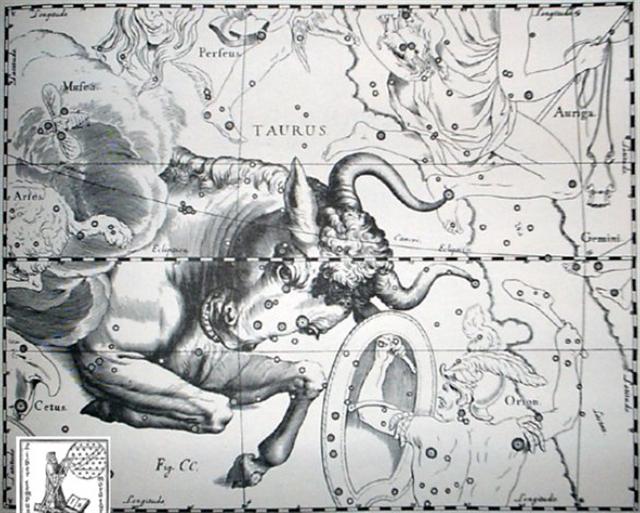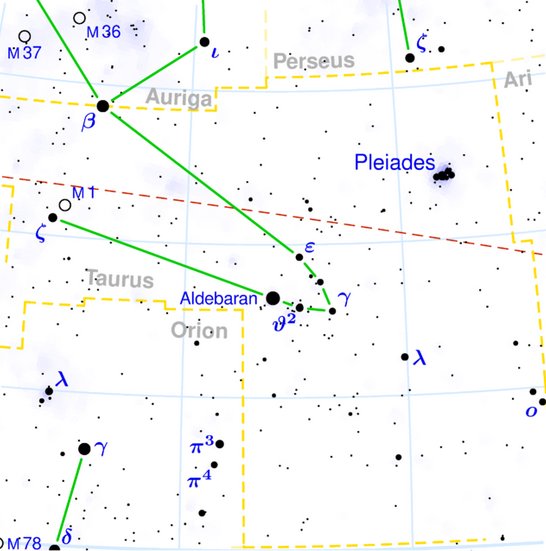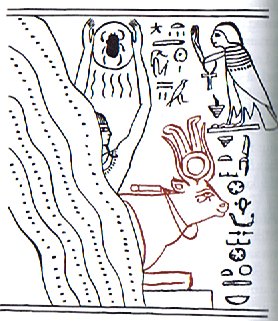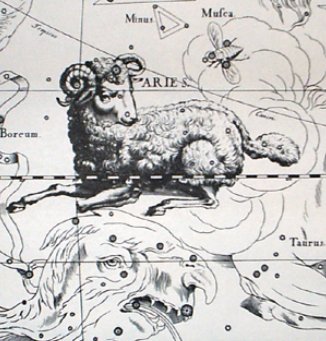Once again, lets look at line Ca3 where the heliacal Pleiades should be:
| April 16 |
17 (107) |
22 |
May 10 (130) |
11 |
| October 16 |
17 (290) |
November 9 |
10 (314) |
 |
 |
 |
 |
| Ca1-26 |
Ca2-1 (27) |
Ca2-24 |
Ca2-25 (51) |
| kua moe ki te tai. |
Te heke |
niu - kupega hia mai |
tu te niu - ku huki |
| POLARIS, Baten Kaitos (26.6), Metallah (26.9) |
Al Sharatain-1 / Ashvini-1 / Bond-16 |
Algenib Persei (50.0), ο Tauri (50.2), ξ Tauri (50.8) |
no star listed |
| Segin, Mesarthim, ψ Phoenicis (27.2), SHERATAN, φ Phoenicis (27.4) |
| no star listed |
Muphrid (210.1), ζ Centauri (210.3 |
Alkalurops (233.1)
Gienah |
Nusakan (234.0), κ¹ Apodis (234.3), ν Bootis (234.7) |
| May 12 |
13 (133) |
14 |
| November 11 |
12 (316) |
13 |
 |
 |
 |
| Ca3-1 (52) |
Ca3-2 |
Ca3-3 |
| kiore - henua |
tapamea |
tagata rere ki te toki - te hau tea |
| no stars listed |
| θ Cor. Borealis (235.3), γ Lupi (235.6), Gemma, Zuben Elakrab, Qin, ε Tr. Austr. (235.7), μ Cor. Borealis (235.8) |
φ Bootis (236.2), ω Lupi (236.3), ψ¹ Lupi (236.7), ζ Cor. Borealis (236.9) |
ι Serpentis (237.4), γ Cor. Borealis (237.7), Unuk Elhaia (237.9) |
| May 10 (130) |
11 |
12 |
| November 9 |
10 (314) |
11 |
 |
 |
 |
| Gb8-17 |
Gb8-18 (460) |
Gb8-19 |
| Algenib Persei (50.0), ο Tauri (50.2), ξ Tauri (50.8) |
no stars listed |
| Alkalurops (233.1)
Gienah |
Nusakan (234.0), κ¹ Apodis (234.3), ν Bootis (234.7) |
θ Cor. Borealis (235.3), γ Lupi (235.6), Gemma, Zuben Elakrab, Qin, ε Tr. Austr. (235.7), μ Cor. Borealis (235.8) |
May 11, day 460 - 329 = 131, is 4 days earlier than day 464 when Tau-ono rose with the Sun:
| May 15 |
16 (136) |
17 |
18 |
| November 14 |
15 |
16 (320) |
17 |
 |
 |
 |
 |
| Ca3-4 (55) |
Ca3-5 |
Ca3-6 |
Ca3-7 |
| kiore ki te henua |
ihe tapamea |
e tagata mau toki ki te henua |
e hokohuki mau ki te matagi |
| Al Thurayya-27 / Krittikā-3 / Hairy Head-18 |
Menkhib (57.6) |
Zaurak (58.9) |
| Atiks, Rana (55.1), CELAENO, ELECTRA, TAYGETA (55.3), MAIA, ASTEROPE, MEROPE (55.6) |
ALCYONE (56.1), PLEIONE, ATLAS (56.3) |
| TAU-ONO |
| π Cor. Borealis, Cor Serpentis (238.1), Chow (238.6) |
κ Serpentis (239.3), δ Cor. Borealis, Tiānrǔ (239.5), χ Lupi, (239.6), ω Serpentis (239.7), Ba, χ Herculis (239.8). κ Cor. Borealis, ρ Serpentis (239.9) |
β Tr. Austr. (240.3), κ Tr. Austr. (240.4), ρ Scorpii (240.8) |
Iklīl al Jabhah-15 / Anuradha-17 / Room-4 |
| ξ Lupi, λ Cor. Borealis (241.1), Zheng (241.2), VRISCHIKA (241.3), ε Cor. Borealis (241.5), Dschubba (241.7), η Lupi (241.9) |
| May 13 |
14 |
15 |
16 (136) |
| November 12 |
13 |
14 (318) |
15 |
 |
 |
 |
 |
| Gb8-20 |
Gb8-21 |
Gb8-22 (464) |
Gb8-23 |
| no stars listed |
Al Thurayya-27 / Krittikā-3 / Legs-15 |
| Atiks, Rana (55.1), CELAENO, ELECTRA, TAYGETA (55.3), MAIA, ASTEROPE, MEROPE (55.6) |
ALCYONE (56.1), PLEIONE, ATLAS (56.3) |
| TAU-ONO |
| φ Bootis (236.2), ω Lupi (236.3), ψ¹ Lupi (236.7), ζ Cor. Borealis (236.9) Acrux |
ι Serpentis (237.4), γ Cor. Borealis (237.7), Unuk Elhaia (237.9) |
π Cor. Borealis, Cor Serpentis (238.1), Chow (238.6) |
κ Serpentis (239.3), δ Cor. Borealis, Tiānrǔ (239.5), χ Lupi, (239.6), ω Serpentis (239.7), Ba, χ Herculis (239.8). κ Cor. Borealis, ρ Serpentis (239.9) |
When Metoro said ihe tapamea at May 16 (136) it probably meant he saw the correct position in time - it was the point (ihe) for 'the red cloth', as also suggested by the pointed form of tapa mea in Ca3-5.
| Ihe A fish. Vanaga.
1. Mgv.: ihe, a fish. Mq.: ihe, id. Sa.: ise, id. Ma.: ihe, the garfish. 2. Ta.: ihe, a lance. Ha.: ihe, a spear. Churchill.

|
| Tapa 1. Side, corner, edge; he-hakarere a te tapa, to leave aside, to abandon; a te tapa mata'u o te haga, on the right-hand side of the bay. 2. Tapa mahute, piece of mahute material; this term is very common nowadays, but it seems probable that it was borrowed from the Tahitian in replacement of parehe mahute. 3. To recount the years, the months; to recount happenings of many years ago, in verses called manu, in which a murderer confided his crime to his victim's relatives; the murderer himself asked a brother or a friend to compose those verses: e tapa koe itooku manu, compose my manu. The expression tapa ite manu was also used of a group of people expressing the desire to kill someone. 4. Tagata tapa ta'u, according to traditions, this term referred to the scribes who recorded births on the tablets. Vanaga.
1. Border, fringe, edge, groin, cloth, clothing, dress, garment. Tatapa, lateral, bank. Tapatapa, edge. P Mgv.: tapa, the edge of the bast cloth, bast cloth in general. Mq.: tapa, fringe, cloth. 2. To name, to mention, to count, to calculate, to reckon, to number, to figure up, to recapitulate; tapa ki te igoa, to take a census; tapa igoa, list. Tatapa, to count, to number, to reckon. Tapatapa, to mention. P Mgv.: tapa, to give a pet name. Mq.: tapatapa, to recite, to invoke; tatapa, to take the name of some one, to announce by name. Ta.: tapa, to call by name. Churchill.
Mq.: Tapaau, coconut leaf plaited to serve as a mat. Sa: tapa'au, a coarse coconut leaf mat. Tapatai, a dweller on the strand. Ma.: tapatai, beach. Churchill. |
The tapa mea glyphs continue and a 2nd birth (hanau) is illustrated in Ca3-9:
| May 19 |
20 |
21 |
22 (142) |
23 |
| November 18 |
19 |
20 (324) |
21 |
22 |
 |
 |
 |
 |
 |
| Ca3-8 (59) |
Ca3-9 |
Ca3-10 |
Ca3-11 |
Ca3-12 |
| kiore i te henua |
tapamea tagata kua iri |
ki te pa |
kua hua |
ki te kotiga |
| λ Tauri (59.3), ν Tauri (59.9) |
4h (60.9) |
no star listed |
Beid (62.2) |
Al Dabarān-2 |
| no star listed |
HYADUM I (63.4) |
| υ Herculis (242.3), ρ Cor. Borealis (242.4), ι Cor. Borealis (242.5), ξ Scorpii (242.7) |
16h (243.5) |
ψ Scorpii (244.6), Lesath (244.8) |
χ Scorpii (245.1), Yed Prior, δ Tr. Austr. (245.5) Vindemiatrix |
Yed Posterior, Rukbalgethi Shemali (246.6). δ Apodis (246.7), ο Scorpii (246.8) |
| Acrab, Jabhat al Akrab (243.3), θ Lupi, Rutilicus (243.5), Marfik (243.7), φ Herculis (243.8) Cor Caroli |
The heliacal rising of Hyadum I in May 23 was the place (-ga) where the old year broke off (koti). In G this was where side b ended, leaving a 1-day gap in the flow of glyphs (which meant there was no need for a koti sign):
| May 20 |
21 |
22 |
23 (143) |
| November 19 |
20 (324) |
21 |
22 |
 |
 |
 |
 |
| Gb8-27 |
Gb8-28 |
Gb8-29 |
Gb8-30 (472) |
| 4h (60.9) |
no star listed |
Beid (62.2) |
Al Dabarān-2 |
| no star listed |
HYADUM I (63.4) |
| 16h (243.5) |
ψ Scorpii (244.6), Lesath (244.8) |
χ Scorpii (245.1), Yed Prior, δ Tr. Austr. (245.5) Vindemiatrix |
Yed Posterior, Rukbalgethi Shemali (246.6). δ Apodis (246.7), ο Scorpii (246.8) |
| Acrab, Jabhat al Akrab (243.3), θ Lupi, Rutilicus (243.5), Marfik (243.7), φ Herculis (243.8) Cor Caroli |
| May 24 |
25 |
26 (146) |
| November 23 |
24 |
25 (329) |
| no glyph |
 |
 |
| Ga1-1 (*65) |
Ga1-2 |
| Hyadum II (64.2) |
Net-19 |
no star listed |
| θ² Tauri, AIN, θ¹ Tauri (65.7) |
| Heart-5 |
ρ Ophiuchi (248.1), Kajam (248.3), χ Ophiuchi (248.5), She Low, ι Tr. Austr. (248.7), ζ Tr. Austr. (248.8) |
Al Kalb-16 / Jyeshtha-18 |
| σ SCORPII (247.0), Hejian (247.2), ψ Ophiuchi (247.7) |
ANTARES (249.1), Marfik, φ Ophiuchi (249.5), ω Ophiuchi (249.8) |
| May 24 |
25 (145) |
26 |
| November 23 |
24 |
25 (329) |
 |
 |
 |
| Ca3-13 (64) |
Ca3-14 |
Ca3-15 |
| kiore i te henua |
tapamea - tagata hoi hatu |
ki te ariki |
| Hyadum II (64.2) |
Net-19 |
no star listed |
| θ² Tauri, AIN, θ¹ Tauri (65.7) |
| Heart-5 |
ρ Ophiuchi (248.1), Kajam (248.3), χ Ophiuchi (248.5), She Low, ι Tr. Austr. (248.7), ζ Tr. Austr. (248.8) |
Al Kalb-16 / Jyeshtha-18 |
| σ SCORPII (247.0), Hejian (247.2), ψ Ophiuchi (247.7) |
ANTARES (249.1), Marfik, φ Ophiuchi (249.5), ω Ophiuchi (249.8) |
 |
 |
 |
 |
 |
| hanau |
Ca3-3 |
Ca3-6 |
Ca3-9 |
Ca3-14 |
| Hanau 1. Race, ethnic group. Hanau eepe, the thick-set race; hanau momoko, the slender race (these terms were mistranslated as 'long-ears' and 'short-ears'). 2. To be born. Hanau tama, pregnant woman; vî'e hanau poki, midwive (also: vî'e hakaa'u). Vanaga.
To be born; vie hanau, midwife. P Pau.: fanauga, child, descendant, progeny. Mgv.: hanau, to be born, to be brought into the world. Mq.: fanau, hanau, to be born, to lie in, to bring into the world. Ta.: fanau, to be born, to lie in. Churchill. |
Hanau at the π glyph (3-14) has both fists held high - nothing has as yet been counted (tapa), no finger has as yet emerged. Tapa mea has at left a straight vertical line, which could indicate a 'line for measurement'. From Metoro's kupega hia mai at niu in May 10 to the Chinese station Net there were 15 days.
May 25 was the first day beyond a square of 8 (64) counted from March 21, and in rongorongo times the day marked by the heliacal rising of Ain (ε Tauri).
| Egyptian jubilation |
 |
Phoenician he |
 |
Greek epsilon |
Ε (ε) |
|
Wikipedia points at the Egyptian gesture with arms held high as a Sign of jubilation, which may have been the origin (via Phoenician he) of epsilon.


|
The hanau type of glyph has a person with wave-like legs spread out and normally with arms held high as if greeting a newborn. The undulating legs could allude to a position on the 'sweet water reef'.
... Fakataka swims and swims, reaching another land. She goes there and stays on the upraised reef in the freshwater pools on the reef, and there delivers her child, a boy child. She gives him the name Taetagaloa. When the baby is born a golden plover flies over and alights upon the reef. (Kua fanau lā te pepe kae lele mai te tuli oi tū mai i te papa). And so the woman thus names various parts of the child beginning with the name 'the plover' (tuli): neck (tuliulu), elbow (tulilima), knee (tulivae) ...
Tae-tagaroa ('Not-Tagaroa') could indicate that the newborn baby should be Tane (the god of trees, i.e. of 'land' in contrast to 'sea'):
... The first line is drawn from Hoku-paa, the fixed or North Star, to the most southerly star of Newe, the Southern Cross. (This hour circle coincides with the meridian on an evening in June, when it would divide the visible sky into halves.) The portion (of the sky) to the right or east of this line (the observer is evidently assumed to be facing north) is called ke ala ula a Kane, the dawning or bright road of Kane, and that to the left or west is called ke alanui maawe ula a Kanaloa, the much-traveled highway of Kanaloa. (Kane and Kanaloa were important gods in the Polynesian pantheon, Kane being associated with light, Kanaloa with darkness.) ...


Hyadum I is γ Tauri, from where the expanding lines representing sky and earth are separating - in the star map above as observed from inside the globe of the sky and in the illustration of Hevelius as observed from a point outside the celestial globe.
We can guess that Tane (Kane in the Hawaiian dialect) ruled from May 24 and Tagaroa (Kanaloa) before May 24.
The peculiar form of Ga1-1 could illustrate how the path here forms a fork.
In ancient Egypt it was a cow instead of a bull - they lived south of the Mediterranean sea and therefore saw everything 'upside down' - and the cow was Hat-hor (the 'House of Horus'):

The Sun 'beetle' is released from his confinement inside his mother. At left is a mountain of rivers, which he has avoided by being inside her womb. The double circle between the horns of Hathor could illustrate the time before his birth.

The Chinese 5th station Heart was marked by σ Scorpii and the Arab's 'Heart' was Al Kalb (Antares).
Hearts are inside (excepting such moments as when the Aztecs ripped open the chest of some victim, grabbed his heart and held it high towards the Sun). In the nakshatra sky of May 25 (where 52 * 5 = 260) both hearts could be seen - a sign that at last the Sun had returned, was outside.
We can now look again at the insect flying towards the Ewe:

Aries is emerging from the clouds at right as if moving withershins. Likewise is Musca Borealis moving against the current of Sun-time. It could mean Tagaroa ruled the time of the Moon.
... In the inscriptions of Dendera, published by Dümichen, the goddess Hathor is called 'lady of every joy'. For once, Dümichen adds: Literally ... 'the lady of every heart circuit'. This is not to say that the Egyptians had discovered the circulation of the blood. But the determinative sign for 'heart' often figures as the plumb bob at the end of a plumb line coming from a well-known astronomical or surveying device, the merkhet. Evidently, 'heart' is something very specific, as it were the 'center of gravity' ... See Aeg.Wb. 2, pp. 55f. for sign of the heart (ib) as expressing generally 'the middle, the center'.
And this may lead in quite another direction. The Arabs preserved a name for Canopus - besides calling the star Kalb at-tai-man ('heart of the south') ... Suhail el-wezn, 'Canopus Ponderosus', the heavy-weighing Canopus, a name promptly declared meaningless by the experts, but which could well have belonged to an archaic system in which Canopus was the weight at the end of the plumb line, as befitted its important position as a heavy star at the South Pole of the 'waters below'.
Here is a chain of inferences which might or might not be valid, but it is allowable to test it, and no inference at all would come from the 'lady of every joy'. The line seems to state that Hathor (= Hat Hor, 'House of Horus') 'rules' the revolution of a specific celestial body - whether or not Canopus is alluded to - or, if we can trust the translation 'every', the revolution of all celestial bodies. As concerns the identity of the ruling lady, the greater possibility speaks for Sirius, but Venus cannot be excluded; in Mexico, too, Venus is called 'heart of the earth'. The reader is invited to imagine for himself what many thousands of such pseudo-primitive or poetic interpretations must lead to: a disfigured interpretation of Egyptian intellectual life ...
|
























